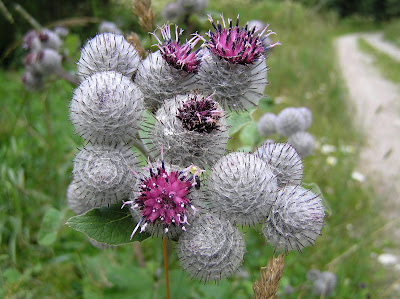Bracts of the involucre glabrous or nearly so. 1. A. minus. Bracts of the involucre copiously woolly. 2. A. tomentosum.
1. Arctium minus Schk. Common. Burdock. (Man. p. i030; I. F. f. 4057.) In waste places, throughout eastern North America. Nat. from Eu.—Pennsylvania: Common throughout the State.
2. Arctium tomentosum (Lam.) Schk. Woolly Or Cottony BurDock. (Man. p. i030 ; I. F. f. 4055.) In waste places, N. B. to Mass. and southern N. Y. Adv. from Eu.—Pennsylvania: Delaware.
1. Arctium tomentosum (Lam.) Schk. Woolly Or Cottony Burdock. (I. F. f. 4055.) Similar to the following species. Heads 16-20 mm. broad, corymbose at the ends of the branches, mostly long-peduncled; bracts of the involucre densely cottony, the inner ones erect and somewhat shorter than the flowers. Ia waste places, N. B. to Mass. and southern N. Y. Adventive from Europe. JulyAug.
2. Arctium Lappa L. Great Bur, Burdock, Or Clotbur. (L F. f. 4056.) Stem much branched, 12-27 dm. high. Leaves thin, broadly ovate, pale and tomentose-canescent beneath, obtuse, entire, repand or dentate, mostly cordate, the lower often 4.5 dm. long; petioles solid, deeply furrowed; heads clustered or subcorymbose, sometimes long-peduncled, 3-4 cm. broad; bracts of the involucre glabrous or nearly so, their spines all spreading; corolla-tube longer than the limb. In waste places, N. B. and Ont to southern N. Y., and locally in the interior. Nat. from Europe. July-Oct.
3. Arctium minus Schk. Common Burdock. (L F. f. 4057.) Smaller than the preceding species, seldom over 15 dm. high. Leaves similar, the lower deeply cordate; petioles hollow, not deeply furrowed; heads numerous, racemose on the branches, short-peduncled or sessile; bracts of the involucre glabrous or slightly cottony, the spines of the outer ones spreading, those of the inner erect and shorter than the flowers; corolla-tube about as long as the limb. In waste places, common throughout our area. Nat. from Europe. July-Nov.
ARCTIUM, burdock, a genus of the polygamia order, and syngenesia class of plants; and in the natural method ranking under the 49fh order, composite capitate : the calyx is globular, with scales having hooks reflected at the tops. There are three species, vis.
1. Arctium lappa ; 2. Arctium personata ; and, 3. Arctium tomentosum. They are all troublesome weeds. Tbe tenderstems of the lappa, or common burdock, however, deprived of the bark, may be boiled and eaten like asparagus. When raw, they are good with oil and vinegar. Boys catch bats by throwing the prickly heads of this species into the air. The seeds, which have a bitterish subacrid taste, are recommended as very efficacious diuretics, given either in the form of emulsion, or in powder, to the quantity of a drachm. The roots, which taste sweetish, with a slight austerity and bitterishness, are esteemed aperient, diuretic, and sudorific ; and said to act without irritation, so as to be safely ventured upon in acute disorders.
Burdock and Velcro
After taking his dog for a walk one day in the early 1940s, George de Mestral, a Swiss inventor, became curious about the seeds of the burdock plant that had attached themselves to his clothes and to the dog's fur. Under a microscope, he looked closely at the hook-and-loop system that the seeds use to hitchhike on passing animals aiding seed dispersal, and he realised that the same approach could be used to join other things together. The result was Velcro.
I (Epukas), the copyright holder of this work, release this work into the public domain. This applies worldwide. In some countries this may not be legally possible; if so: I grant anyone the right to use this work for any purpose, without any conditions, unless such conditions are required by law.
TEXT CREDIT:
- Manual of the flora of the northern states and Canada.
- Flora of Pennsylvania
- A new and complete dictionary of arts and sciences














No comments:
Post a Comment